Table of Contents[Hide][Show]
A nourishing homemade baby formula using safe, whole ingredients. This recipe was developed and tested by Dr. Mary Enig, a PhD Nutritionist and originally published in Nourishing Traditions cookbook in 1996. It was formulated to match breastmilk as closely as possible and is also suitable for infants. Source: Weston A. Price Foundation
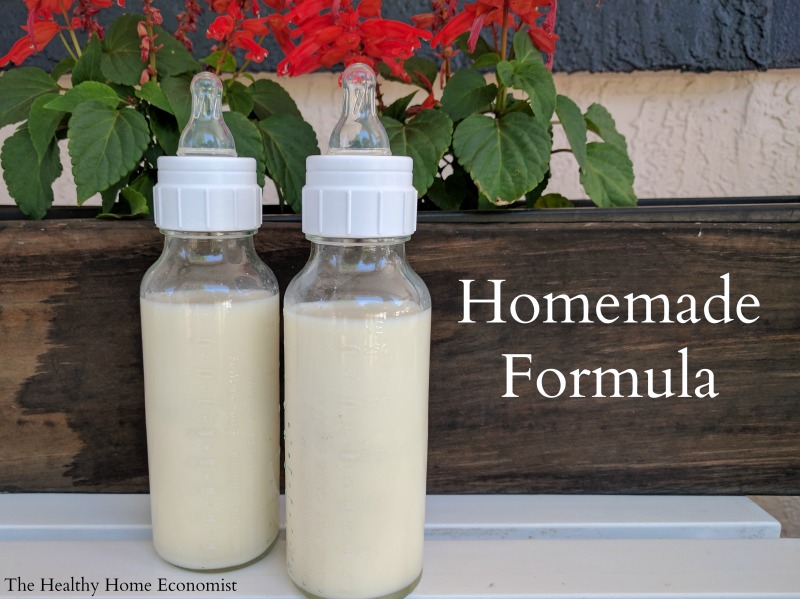
There is no doubt that breastfeeding your baby is the best option for the child’s long-term health and development. Human breastmilk from a well-nourished mother is the perfect food for baby. However, in circumstances where the child is adopted or the Mother finds herself unable to breastfeed, formula feeding becomes necessary. In those cases, homemade baby formula is best.
Using a baby formula recipe that closely matches the nutritional profile of breastmilk is a far better choice than even organic baby formula from the health food store. More on this below.
Note: Donor programs are widely available for human breastmilk. But, the diets of the donor mothers are unknown and most likely nutritionally insufficient. In addition, breastmilk banks pasteurize the donated breastmilk which destroys much of the nutritional benefit. Unless you are fortunate to have a trusted and direct donor milk source in your community, avoid this option!
Dangers of Commercial Formula
Commercial formulas are always a poor choice for a number of reasons. First of all, formula manufacturers line the cans with the chemical BPA. This substance disrupts hormone development and is a probable contributor to early puberty in girls, and ADHD, urogenital abnormalities, and other ills in boys.
The European Food Safety Authority found that canned commercial formula is a significant source of BPA for infants, exposing the child to 13mcg of BPA per kg of body weight per day! BPA-free formula cans are no better. The chemical BPS is typically used instead which is just as dangerous.
Beware that manufacturers pack even organic commercial formula like Earth’s Best in BPA cans. Worse, they use organic brown rice syrup as the primary sweetener which is known to be frequently contaminated with arsenic.
In addition, all commercial milk formulas are processed at extremely high temperatures which violently denature the fragile milk proteins, render them allergenic, and add carcinogens to the final product. Soy infant formula is the worst. Obscenely high processing temperatures not only denature the proteins but large levels of phytic acid in soy block mineral absorption by the infant. Moreover, soy-based plant estrogens disrupt the hormonal development of the baby!
It seems that for the concerned Mother who is unable to breastfeed, learning how to make baby formula at home with safe, pure ingredients is the most prudent way to go!
Why Make Homemade Formula Even if You Are Breastfeeding
In the video below, I show you how to make your own safe, healthy raw milk homemade formula for your baby.
The recipe I follow was originally published in the cookbook Nourishing Traditions in 1996 and developed by Dr. Mary Enig.
Even though I breastfed each of my children for at least 2 years, I made this exact formula for my own children when I was away for the day or the evening as pumping was not an option that worked well for me.
I even used this homemade formula for an entire day once when I had some dental work done and was advised to pump and discard for 24 hours.
As a result, even successfully breastfeeding Moms can use this wonderful homemade formula as a supplement when necessary to their own nutrient-dense breastmilk!
It is advised that even breastfeeding Mothers have the ingredients for this formula on hand for an emergency. If Mom is sick or otherwise unable to nurse, Dad can step in and make this safe alternative until Mom is back on her feet. It takes a few days to a week to gather all the ingredients together to make this formula, which is why I advise having them on hand at all times.
Homemade Most Nutritious
The image below lists the reasons why it is worth it nutritionally to make formula yourself for your precious baby!
You can order all of the required ingredients for the homemade baby formula in one package from this reputable, vetted source.
Moms who have successfully used this formula feeding your children, please post about your experience in the comments section to encourage those who are considering it and need some Mom to Mom encouragement!
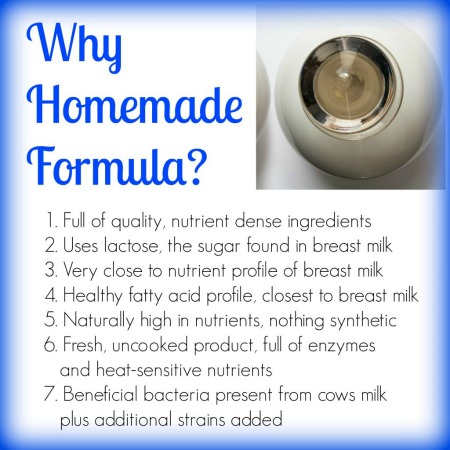
Where to Source Quality Milk
The most widely available grass-fed milk around the world is from cows. This is usually the most budget-friendly and easily sourced milk for this recipe for homemade formula.
If only goat milk is available in your area, this recipe for goat milk baby formula can be used instead. When using milk from ewes, please refer to the linked article for an adjusted recipe; one of the benefits of sheep milk is that it is higher in healthy fats than either goat or cow milk.
Camel milk formula is another option that is a particularly digestible form of dairy and growing in popularity around the world.
Alternatively, you can use low temp (vat) pasteurized, non-homogenized whole milk cultured with a piima or kefir starter. Then substitute the piima milk or kefir for the raw milk portion of the formula recipe. Cold-pressed raw milk also must be cultured before using it as it contains no probiotics.
Do NOT use ultrapasteurized (UHT) milk even if organic as it is too highly processed and extremely allergenic!
It is also best to avoid all types of powdered milk for this recipe. The factory process of making milk powder reduces nutrition considerably and denatures it, which makes it more likely baby will have an allergic reaction.
Dairy Allergy Option
If all types of dairy prove unsuitable for your baby, make this nondairy baby formula recipe instead. It uses a base of homemade bone broth as a substitute for milk. It is important not to utilize a plant-based or otherwise vegan baby formula recipe.
Avoid buying bone broth to make the dairy-free formula. Make it yourself! Manufacturers of commercial bone broth, even if authentic, may water down the end product. This is apparent if it does not gel when chilled in the refrigerator.
Many brands have toxic packaging issues as well. If you must buy it in a pinch, see my shopping guide page for vetted brands that are safe.
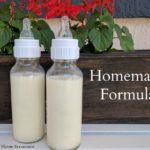
Homemade Baby Formula Recipe (for infants too)
A nourishing baby formula recipe you can make at home with safe, whole ingredients developed and tested by a PhD nutritionist to match breastmilk as closely as possible. Also suitable for infants.
Ingredients
- 2 cups raw cow milk OR organic whole milk yogurt
- 1 7/8 cups filtered water
- 1/4 cup liquid whey
- 4 Tbl lactose
- 1/4 tsp Bifidobacterium infantis powder
- 2-4 Tbl raw or pasteurized cream
- 1/2 tsp cod liver oil unflavored
- 1/4 tsp butter oil unflavored
- 1 tsp sunflower oil preferably organic
- 1 tsp extra virgin olive oil preferably organic
- 2 tsp virgin coconut oil preferably organic
- 2 tsp nutritional yeast
- 2 tsp gelatin
- 1/4 tsp acerola powder
Instructions
-
Fill a 2 cup Pyrex measuring cup with filtered water and remove 2 TBL (this will give you 1 7/8 cup water).
-
Pour about half the water into a pan and turn burner on medium.
-
Add the gelatin and lactose and let dissolve, stirring occasionally.
-
When gelatin and lactose are dissolved, remove pan from heat and add the rest of the water to cool.
-
Stir in the coconut oil and butter oil until melted.
-
Put remaining ingredients in a glass blender.
-
Add the water mixture and blend for about 3 seconds.
-
Place formula in glass baby bottles or a glass jar and refrigerate.
-
Before giving to baby, warm glass bottle in a pan of hot water or a bottle warmer. NEVER microwave baby bottles!
Recipe Video
Recipe Notes
If using raw cow milk from holstein cows, use 4 Tbl of extra cream (otherwise use 2 Tbl extra cream).
If choosing to make this homemade formula with camel milk, be sure to include 4 Tbl extra cream as camel milk is lower in cream than cow milk.
Do not use high oleic sunflower oil. Use only the brand recommended in the ingredients list which is cold pressed, organic, unrefined, and low oleic.
*Do NOT use powdered whey from the store as it is denatured. Avoid whey from making cheese as it will curdle the formula.
*Do not substitute pasteurized or powdered milk as these are heavily processed, denatured and allergenic foods.
*Do NOT use ultrapasteurized (UHT) cream. It is highly allergenic. Raw or pasteurized cream is acceptable.
*Do NOT use fish oil or krill oil instead of high vitamin cod liver oil as they do not contain any Vitamin D and very little to no Vitamin A.
Collagen powder may be substituted for the gelatin in a pinch (more on peptides in baby formula in this article).
If you are wondering where is the iron in homemade baby formula, this article provides an explanation.
If baby experiences constipation using this formula, try adding 1 tsp of molasses to each batch. This should help move things along.
How to Transition to DIY Formula
Once you’ve viewed the video, gathered the ingredients, and made your first batch, how do you feed it to your baby for the first time?
It is important not to switch all at once as this can cause gas, excessive spit-up, or an uncomfortable change in diaper habits such as constipation or overly loose stools.
Start by giving your baby three-quarters of the old formula blended with one-quarter of the homemade. Try this ratio for a day or two and see how your infant responds.
If no digestive upset or major change in diaper habits occurs, increase the amount to a 50-50 blend of old formula to homemade. Observe for another day or two as before.
If no major issues, increase once again to three-quarters homemade formula to one-quarter old formula. If baby does well on this blend for a third time, you are ready to fully transition to the homemade formula.
At any time during the transition, symptoms of intolerance emerge, back up to the previous successful blend ratio and stay there for a day or two before attempting to increase once again.
Homemade Formula FAQ
Weston Price Foundation
Feeding an Adopted Baby
Traveling Tips with Baby Formula Made at Home
Iron in Baby Formula
Collagen Peptides instead of Gelatin for Homemade Formula?


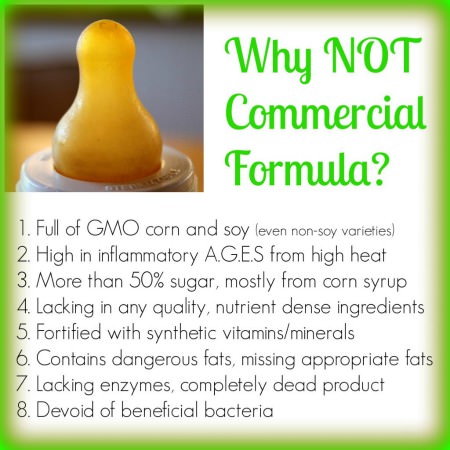
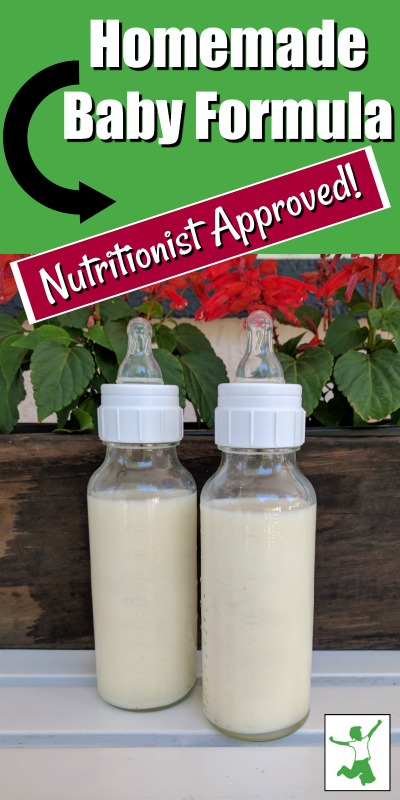






Hi Sarah,
I just started using the homemade baby formula with my 9 month old daughter. I breastfeed first and then offer the bottle (my supply is very, very low). She is having very runny (maybe diarrhea) bowel movements. Does this mean she is allergic or do I need to give her time to adjust? She has been on it for 2 days now. Thanks!
It takes at least a week to adjust. 2 days is not long enough and you should gradually increase the amount of homemade formula very very slowly over the span of a week to 10 days or so.
Hi Sarah, I made a batch two months ago to supplement with, so they were kept in the freezer. I know raw milk can be frozen for several months safely, what are your thoughts on this formula being frozen for that long? How long would you feel safe having it it frozen? Thanks in advance!
It’s probably fine. Two months is not that long for it to be frozen. 6 months or more, I would say toss it.
Hi Sarah, thank you for this formula recipe. When my baby girl was born the nurse at the hospital pushed the store formula because I wasn’t producing enough breast milk. I’m a cancer survivor and only produced milk on one breast. My baby took the store formula for about 3 months and then she just would not take it. At the same time I started seeing a local chiropractor who shared your blog. I immediately started giving my baby the formula per your recipe and she loved it! She was 3 months when I started this formula and now she is 6 months, she still drinks it well but she is having a lot of trouble with her bowel movements. I have delayed introducing her to actual food because I don’t want the constipation to get worse. Is there something that you can recommend to help my baby’s constipation? Any advice you may give would be greatly appreciated.
Hi Diana, glad the formula is working well for you! Here is an article with suggestions on how to gently remedy issues with baby constipation. Hope this helps! https://www.thehealthyhomeeconomist.com/relieving-baby-constipation-naturally/
Is it possible to do all raw milk (besides a half cup of water, to dissolve the lactose and gelatin in) if I don’t have raw or pasteurized cream? If my math is correct, it should have roughly the same fat content as this recipe if I were to do that, but I want to make sure it’d still meet all the other vitamin and caloric needs. Thank you!!
You MUST add the cream. This is especially important if the raw milk comes from holstein cows. If you click on the cream ingredient in the recipe above, it goes to a link where you can buy pasteurized cream. Also, Whole Foods carries Natural by Nature grassfed pasteurized cream, so it is widely available.
Hi Sara.. This may be a silly question but do you freeze your batch just like breast milk?!
Refrigerate and use up within 1-2 days. You can freeze some for emergencies.
Oh sorry. I didn’t see the article. But that’s good that I can use yogurt when I can’t get to the farm for fresh raw milk. I guess raw milk is safer bc it has antobodies like mothers milk.
If I can’t always get raw milk can I use whole grass fed pastarized milk? I love the idea of using raw milk from a trusted farm but there’s only one place I can get it from and I can’t always get there. In my state it can only be sold on the farm where it is obtained so it’s not easy to get. I do like the idea of the natural formula. When my daughter lost too much weight four days after birth our pedeatrician recommended we supplement with formula or pump. Before I got a pump and got the hang of pumpibg; formula was the best option. The Dr recommended enfanel. I wasn’t too happy with the ingredients my my daughter like the taste and it helped her gain weight so I continued to give her two oz twice a day. Even now that I got the hang of pumping I find the formula helpful and I don’t
always have time to pump.I would’ve switched to a more natural formula but I figured for the amount used this was fine. I like that your recipe uses whole milk. Why does commercial formula use fat free milk then add back fat with inferior oils? Is it more shelf stable? Anyway I would definitely consider following your recipe.
As stated very clearly in the article, you absolutely ***CANNOT USE PASTEURIZED MILK FOR THIS FORMULA***. Also suggested in the recipe above, if you cannot get raw milk, use whole milk plain organic yogurt or kefir (properly fermented) in place of the milk instead.
HI Sarah, I love your blog, so much useful info! Came across it when I was researching on L-ascorbic acid. And then I checked baby category.
I have been making home made formula after I stopped breastfeeding at 11 months. Our daughter is 17 months now. I am using exactly this recipe, but I found it in the book “Super Nutrition for Babies” (this is my go-to book when it comes to baby nutrition questions). I order raw milk, cream yogurt, cheeses and meats from our trusted local Amish farmers. Our baby loves the formula and its light coconut taste and she is thriving.
ALso, when I was breastfeeding, I noticed that she had an allergy to pasteurized dairy products in my milk. The one of my holistic friends recommended that I try raw dairy products. After I switched, all problems disappeared. This is an example that pasteurized products are bad for our bodies.
That’s great news! Thanks for sharing! One thing to note (forgive me if I misunderstood) … if your baby is now 17 months old, she no longer requires the homemade formula. The homemade formula is designed for babies up to 1 year old. After the first birthday, plain raw grassfed milk is fine.
Hi Sarah I have already tried sheep milk with the twins and they both was vomiting just as bad as with the raw cow milk. I didn’t notice any improvements. I’ve also tried removing the gelatin and adding it back and I removed sunflower oil and added it back because I didn’t see any improvement with that as well. Is there any thing else you would recommend I do?
Have you tried yogurt or kefir in place of the raw milk portion of the recipe? Raw kefir would be best. https://www.thehealthyhomeeconomist.com/video-thursday-how-to-make-kefir/
After that, you should probably go to the bone broth formula then.
https://www.thehealthyhomeeconomist.com/video-hypoallergenic-baby-formula/
Hi Sarah thanks for responding to my last comment. My twins have been on the raw milk formula for about a month now and I’m needing to know how to increase the calories for my little girl. She weighted 6.1 lbs at birth lost down to 5.6 and now at almost 4 months she is only 8.6 lbs. I’m worried she isn’t gaining weight well. I’m really not sure if she is tolerating the raw milk or some other ingredient. Some days are better then others with spitting up but I don’t think it’s enough for her to not gain any weight. At this time I don’t have a source for goat milk or I would try that. Would you recommend the meat formula if she is having trouble gaining weight?
Try sheep milk formula or camel milk formula before the broth based formula. Sheep formula is made with sheep yogurt available at Whole Foods. Camel milk can be shipped to your door legally. Here are recipes:
https://www.thehealthyhomeeconomist.com/camel-milk-homemade-baby-formula/
https://www.thehealthyhomeeconomist.com/sheep-milk/